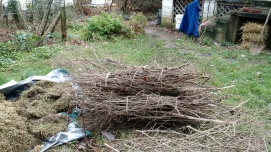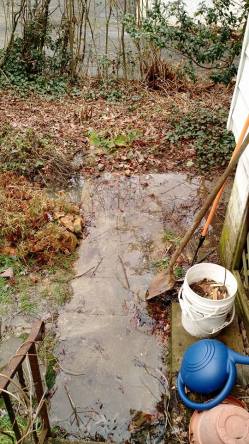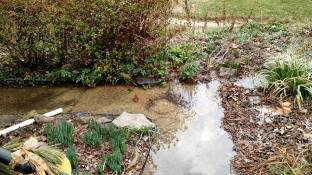Wintry temperatures at last! Evenings dipping into the 20s and days barely above 40. The water in the hugelkultur trench finally receded, the ground was firm enough to walk upon dry-shod, and I’d cleared and sorted most of the brush pile. The birds will have plenty, even after I’ve bundled enough branches into composite logs to hold up the full length of the  berm….
berm….
And then the temperatures yo-yo’d again today, bringing rain to turn the  backyard again into swamp and overflow the inlets I’d dug into my side gardens. When Chase Ridgely of Cashmere Rose Farms dropped by to squelch across the property today and offer some suggestions, he witnessed the full scope of the challenge!
backyard again into swamp and overflow the inlets I’d dug into my side gardens. When Chase Ridgely of Cashmere Rose Farms dropped by to squelch across the property today and offer some suggestions, he witnessed the full scope of the challenge!
 So what did he recommend, from the depth of his experience as an instructor in biodynamic farming and holistic management?
So what did he recommend, from the depth of his experience as an instructor in biodynamic farming and holistic management?
Certainly, he felt that the hugelkultur berms were a good idea…adding that, with the mycelium-bearing wood at their foundation, they would be best suited to growing perennial herbs, shrubbery and trees. But he also added that I could mitigate the packed, compacted clay of my yard by aerating and re-mineralizing the soil with gypsum, azomite, humates, Jersey greensand, and plenty of compost as sheet mulch.
I could spread this combination (proportions yet to be discovered – he’s sending info) across all or part of  the yard; plant Daikon radish, carrots, turnips, and red clover into it; and let the roots burrow deep into the hard soil – even finding a way through that mosaic of rubble at the 18-inch mark, he said. Through the summer, I could mow over it if I choose, or let the (glorious) foliage stand…harvest the crop at season’s end or just let the roots rot in the ground to produce plugs of organic matter. Come August, plant more or these root crops next to the spring’s plants and let these new plantings grow and die back in the winter. Each one would break up the compacted soil a little more, while the amendments would replace the minerals lost through decades of erosion.
the yard; plant Daikon radish, carrots, turnips, and red clover into it; and let the roots burrow deep into the hard soil – even finding a way through that mosaic of rubble at the 18-inch mark, he said. Through the summer, I could mow over it if I choose, or let the (glorious) foliage stand…harvest the crop at season’s end or just let the roots rot in the ground to produce plugs of organic matter. Come August, plant more or these root crops next to the spring’s plants and let these new plantings grow and die back in the winter. Each one would break up the compacted soil a little more, while the amendments would replace the minerals lost through decades of erosion.
Best of all, this process could build topsoil above the soil I have, increasing its capacity to absorb water, while opening up the mosaic of rubble below. I would not – repeat, not – have to excavate and remove that nightmarish layer of stones and concrete!
What wonderful news!
I’ve spoken also with Jack Eaton of Filtrexx, a company that manufactures materials for living walls, stabilizing mesh against stormwater-based erosion and much more. We’ll be talking again this week, I hope with my uphill neighbor taking part in the conversation, to find solutions for that  retaining wall which is slowly, slowly tipping toward collapse into my yard under the pressure of water sluicing over and underneath the driveway.
retaining wall which is slowly, slowly tipping toward collapse into my yard under the pressure of water sluicing over and underneath the driveway.
Meanwhile I take care of my clients, and participate in the volunteer marketing committee for Biodiversity for a Livable Climate, an organization dedicated to raising awareness that capping carbon emissions is just one side of solving the climate challenge: it is possible to mitigate – even reverse – the effects of climate change by restoring ecosystems at the local, grassroots level.
Property by property. Street by street. Community by community. Whether by an National Wildlife Federation backyard habitat, a Chesapeake Bay Better Backyard, a Food Not Lawns garden, a “Paradise Lot” mini-food forest, or a full-fledged CSA garden. The options to heal the land, conserve the water, and produce sustainable, healthy food and habitat for humans and wildlife alike, are endless.
Holding that vision ahead as I move through this process. It’s not just about my soggy, eroding property. It’s ultimately about the learning and resources I’ll be able to share with the community…and the ways we, together, can help to heal the planet.
Thanks for sharing your learnings!
LikeLike
Thank you for sharing your discoveries on your property! What fun to be blogging side by side….
LikeLike